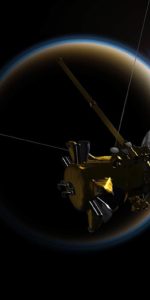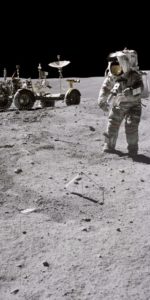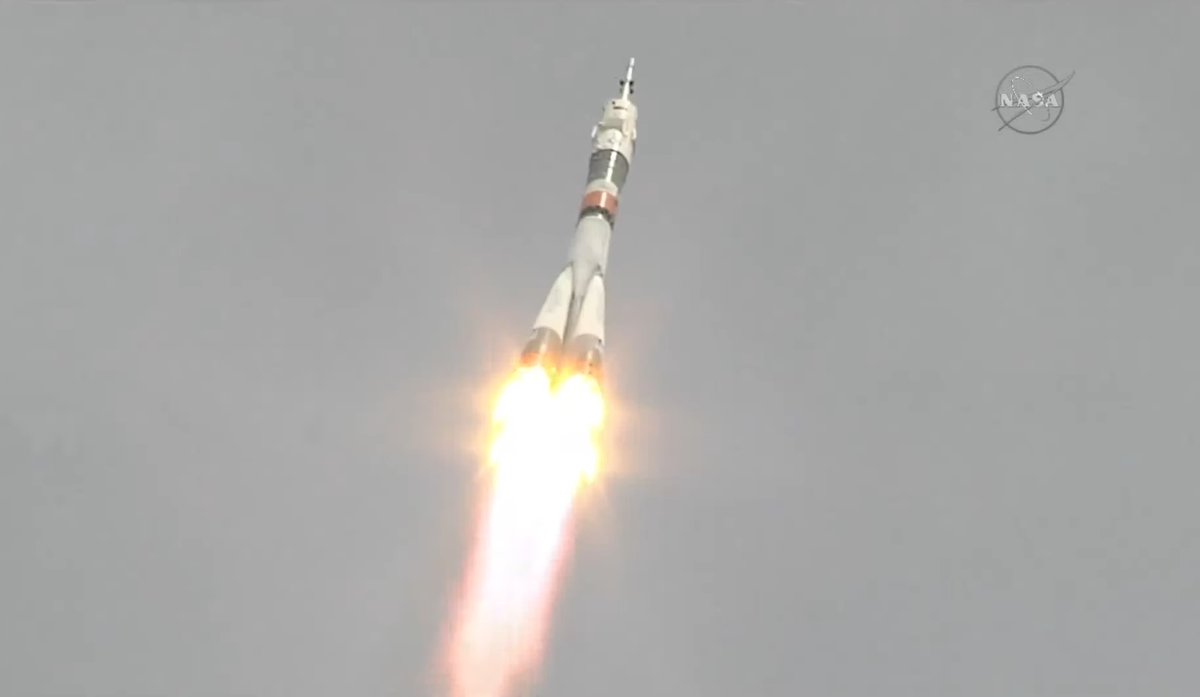
Russian cosmonaut Fyodor Yurchikhin and U.S. astronaut Jack Fischer have launched safely into orbit aboard their Soyuz MS-04 spacecraft, bound for a 4.5-month occupancy of the International Space Station (ISS). The duo—who represent the smallest Soyuz crew to be launched over a decade—rocketed away from Site 1/5 at the Baikonur Cosmodrome in Kazakhstan at 1:13:43 p.m. local time (3:13:43 a.m EDT) Thursday, 20 April. Within nine minutes, Yurchikhin and Fischer achieved orbit and began a six-hour and four-orbit “fast rendezvous” to reach the space station.
At the time of writing, the crew are in the process of executing up to five Delta-Velocity (DV) “burns” of their spacecraft’s maneuvering thrusters to align their orbital parameters with that of the ISS. Docking with the station’s space-facing (or “zenith”) Poisk module is targeted for 9:23 a.m. EDT. After a couple of hours of pressurization and leak checks, hatches will be opened and Yurchikhin and Fischer will join Commander Peggy Whitson and Flight Engineers Oleg Novitsky and Thomas Pesquet to round out Expedition 51.
As outlined in AmericaSpace’s Soyuz MS-04 preview article, Yurchikhin and Fischer’s flight has undergone significant changes in recent months, following Russia’s decision last summer to reduce the number of its cosmonauts aboard the ISS from three to two throughout 2017 and much of 2018. This resulted in a moving-around of crew members, as several U.S. astronauts were required to re-train for the systems-intensive Flight Engineer-1 role aboard the Soyuz. Whilst a couple of astronauts’ flights were moved back to allow them to complete this training, others—including Fischer—benefited from the change, as they had already been assigned to the Flight Engineer-1 role from the outset.
Therefore, Yurchikhin and Fischer’s launch was moved forward from May to March 2017, although in mid-January Tass announced that their spacecraft (serial-numbered “734”) would be replaced by a new vehicle (“735”). It later became clear that a leak in the bell-shaped descent module was a factor and by early March Soyuz MS-04 was officially scheduled to launch no sooner than 20 April. Last week, the spacecraft was encapsulated within its payload shroud and integrated into the mammoth Soyuz-FG booster. Following last December’s high-altitude loss of the Progress MS-04 cargo ship—caused by a third-stage engine malfunction in its Soyuz-U rocket—fleetwide engine inspections were prompted. The third stage of Yurchikhin and Fischer’s Soyuz-FG has since been replaced with a new engine, from a different production lot.
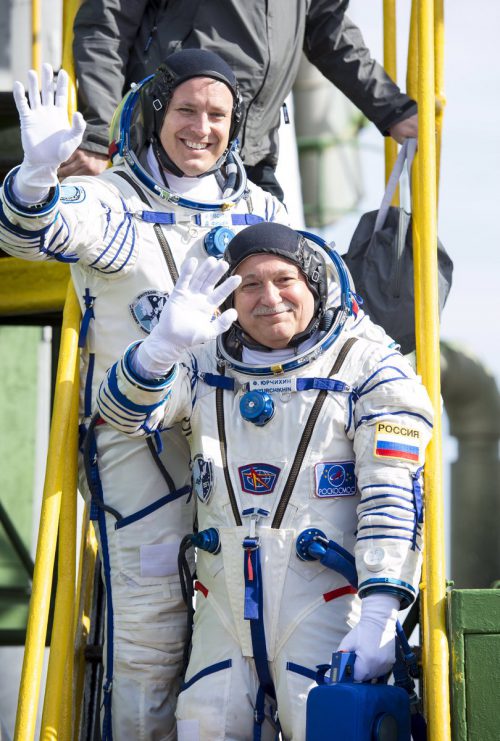
Early Monday, the 162.4-foot-tall (49.5-meter) booster was rolled horizontally out of the Baikonur integration facility and taken to Site 1/5. Nicknamed “Gagarin’s Start”, this was the same site from which Yuri Gagarin began his pioneering spaceflight, 56 years ago this month. Watching the rollout was veteran astronaut Randy Bresnik, who serves as Fischer’s backup for this mission, and will himself launch to the ISS in late July. “Impressive to see this massive launch vehicle,” Bresnik tweeted, “hoisted into the vertical with only inches to spare as it is inserted into the launch pad.”
Yesterday (Wednesday), the prime crew and their backups—Bresnik and Russian cosmonaut Sergei Ryazansky—gathered before the State Commission, where they were declared ready to fly. Later that day, in his last tweet from the planet, Fischer shared an image with his 39,700 followers. It showed himself and Yurchikhin posed before the early spring blooms of Baikonur. “#1team, 2 happy guys & a whole bunch of spring blooms,” Fischer wrote. “Crew is ready to launch tomorrow!” Then, closing out his final on-Earth tweet, he added, in Cyrillic, the word Poyekhali (“Let’s Go!”), mirroring the words of Yuri Gagarin as he departed Site 1/5, all those years ago.
The two crews were awakened in Baikonur’s Cosmonaut Hotel about 8.5 hours prior to today’s 1:13 p.m. local time (3:13 a.m. EDT) launch. They showered and were disinfected, then submitted to microbial samples in support of the ISS research investigations that they will perform on-orbit. After ceremonially autographing the doors of their hotel rooms and receiving a blessing from a Russian Orthodox priest, they proceeded via bus to Site 254 to don their Sokol (“Falcon”) launch and entry suits.
Here, Yurchikhin and Fischer were screened behind glass, offering them a final opportunity to bid farewell to their families and friends, including photographs and fist-bumps with their children. “Take excellent care of Space Station for us,” said Bill Gerstenmaier, NASA’s Associate Administrator for Human Exploration and Operations, who was seated in the audience. Veteran astronaut Doug Wheelock—who flew a Soyuz and completed a 5.5-month expedition to the ISS in 2010—described their feelings as: “Head full of procedures, heart full of wonder!”
The prime crew then headed out to Site 1/5 at 10:13 a.m. local time (12:13 a.m. EDT), arriving at the launch pad about 25 minutes later. Yurchikhin was inserted into the center commander’s seat of Soyuz MS-04’s descent module, with Fischer taking up his own position in the Flight Engineer-1 couch on the left-hand side of the vehicle. In keeping with tradition, Fischer selected music to be piped into the cabin during the last hour or two of the countdown. He recently tweeted that he had chosen his all-time favorite song—Garth Brooks’ “The River”—as well as the Air Force song, Kenny Loggins’ “Danger Zone” from the movie Top Gun and Frank Sinatra’s “Fly Me to the Moon”. The latter tune was selected jointly by Fischer and his wife, Elizabeth.
Already loaded aboard the Soyuz-FG was a highly refined form of rocket-grade kerosene, known as “RP-1”, with liquid oxygen being continuously topped-off until close to T-0, to ensure that boiled-off cryogens were kept replenished and maintained at “Flight Ready” levels. At 12:58 p.m. local time (2:58 a.m. EDT), with about 15 minutes to go, the Launch Abort System (LAS) was armed and transferred to Automatic Mode and Yurchikhin and Fischer were instructed to close their space suit visors.
At T-5 minutes, Yurchikhin’s controls were activated and internal avionics aboard Soyuz MS-04 were spooled-up to monitor booster systems throughout ascent. From within the control bunker, the “launch key”—an actual, physical key—was inserted to enable the booster’s ordnance. Propellant tanks were pressurized and it was transferred from ground support utilities onto internal power, with the twin umbilical towers retracting away from the vehicle. Three minutes and 27 seconds before launch, the ISS passed directly over Baikonur, and was about 251 miles (404 km) over north-eastern Kazakhstan at T-0.
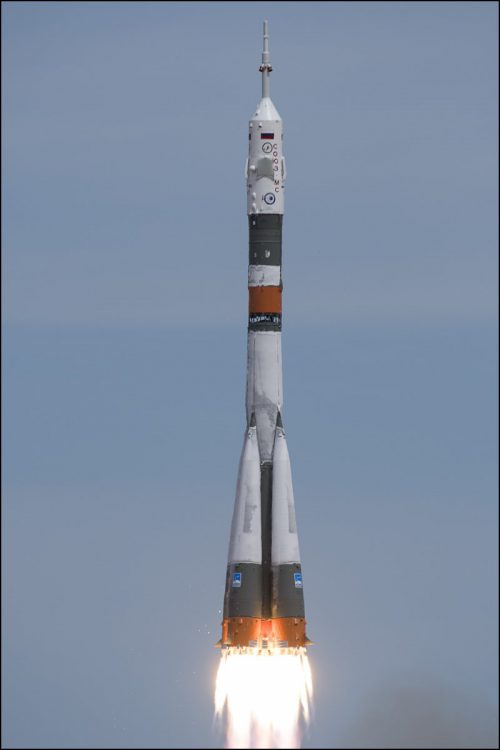
Ten seconds before T-0, the turbopumps of the RD-108 first-stage engine and the RD-107 engines of the Soyuz-FG’s four tapering, strap-on boosters attained full speed. Five seconds later, the engines themselves ignited and ramped up to full power, before Site 1/5’s fueling tower retracted and Soyuz MS-04 roared into the early-afternoon Baikonur sky at 1:13:43 p.m. local time (3:13:43 a.m. EDT). With the four tapering boosters and the central core powering the initial launch phase, a total of five engines punched out a combined total of 930,000 pounds (422,000 kg) of thrust to lift the 672,000-pound (305,000 kg) rocket away from Earth and onto a six-hour, four-orbit journey to reach the ISS.
There was little to say, other than to will Yurchikhin and Fischer onto a smooth journey to orbit. “Go @Astro2fish go,” tweeted Fischer’s fellow astronaut and classmate Kjell Lindgren. “Godspeed!” Added Canadian astronaut Jeremy Hansen: “Go Time!” Meanwhile, the European Space Agency (ESA) offered its own good wishes: “The boys are in space.”
Less than two minutes after liftoff, the strap-on boosters—each of which measures 64 feet (19.6 meters) in length—were exhausted and jettisoned from the stack. By this point, Yurchikhin and Fischer were already traveling in excess of 1,100 mph (1,770 km/h). With the boosters gone, the core continued to burn hot and hard, until the RD-108 burned out at four minutes and 43 seconds after liftoff. At the instant of RD-108 shutdown, the Soyuz-FG and its human cargo had reached an altitude of 105.6 miles (170 km).
Next came the turn of the third stage, which executed a so-called “Hot Stage” burn, igniting its single RD-0110 engine whilst still attached to the core. A few seconds later, the 89-foot-tall (27.1-meter) core stage was jettisoned. The third stage pushed Soyuz MS-03 to a velocity in excess of 13,420 mph (21,600 km/h) and burned for four minutes, until it shut down at eight minutes and 45 seconds into the flight. By the time of RD-0110 cutoff and the separation of the 22-foot-long (6.7-meter) third stage, Soyuz MS-04 had attained a preliminary orbit with an apogee of 143 miles (230 km) and a perigee of 118 miles (190 km), inclined 51.66 degrees to the equator.
It has become traditional for Soyuz crews to include fluffy toys, usually provided by the children, to “hang” inside the spacecraft, which would serve as their first indicator of the onset of microgravity. In Soyuz MS-04’s case, Yurchikhin chose toys from his children and Fischer poignantly selected a stuffed emblem of the MD Anderson Cancer Center in Houston, Texas, where his daughter, Sariah, was treated. During launch, one of the toys—a cute-looking dog—hung in front of Yurchikhin’s face as the main gravity indicator. Nine minutes after leaving Baikonur, the dog quit “hanging” and started “floating”, providing proof-positive that the two men were officially on-orbit.
Shortly after orbital insertion, the crew deployed Soyuz MS-04’s electricity-generating solar arrays and communications and navigation antennas, before settling into a condensed phase of rendezvous maneuvers, ahead of docking at the ISS about six hours later. Although same-day rendezvous and docking has been done by most missions since March 2013, it has yet to be done by the upgraded Soyuz-MS spacecraft. The inaugural two flights of the new vehicle, July and September 2016, adopted extended two-day rendezvous profiles to test systems, whilst last November’s launch of Soyuz MS-03 did likewise, due to the requirements of orbital mechanics and phasing.
Next up for Yurchikhin and Fischer will be a series of up to five Delta-Velocity (DV) “burns” to align their orbital parameters with that of the space station and its waiting Expedition 51 crew of Commander Peggy Whitson and Flight Engineers Oleg Novitsky and Thomas Pesquet. According to the timeline, Soyuz MS-04 will dock at the station’s space-facing (or “zenith”) Poisk module at 9:23 a.m. EDT, some six hours and ten minutes into the mission. When the hatches are opened a couple of hours later, they will join Whitson, Novitsky and Pesquet to form the first five-person long-duration ISS crew for more than seven years.
Be sure to “LIKE” AmericaSpace on Facebook and follow us on Instagram & Twitter!




